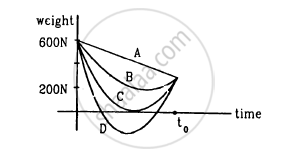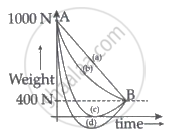Advertisements
Advertisements
Question
A particle is fired vertically upward with a speed of 15 km s−1. With what speed will it move in interstellar space. Assume only earth's gravitational field.
Solution
Initial velocity of the particle, v = 15 km/s
Let its speed be v' in interstellar space.
Applying the law of conservation of energy, we have:
\[\left( \frac{1}{2} \right)m\left[ v - v '^2 \right] = \int_R^\infty \frac{GMm}{x^2}dx\]
\[ \therefore \left( \frac{1}{2} \right)m\left[ 15 \times {10}^3 - v '^2 \right] = \int_R^\infty \frac{GMm}{x^2}dx\]
\[ \Rightarrow \left( \frac{1}{2} \right)m\left[ \left( 15 \times {10}^3 \right)^2 - v '^2 \right] = GMm\left[ \frac{- 1}{x} \right]\]
\[ \Rightarrow \left( \frac{1}{2} \right)m\left[ \left( 225 \times {10}^5 \right) - v '^2 \right] = \frac{GMm}{R}\]
\[ \Rightarrow 225 \times {10}^5 - v '^2 = \frac{2 \times 6 . 67 \times {10}^{- 11} \times 6 \times {10}^{24}}{6400 \times {10}^3}\]
\[ \Rightarrow v '^2 = 225 \times {10}^6 - \frac{40 . 02}{32} \times {10}^8 \]
\[ = 2 . 25 \times {10}^8 - 1 . 2 \times {10}^8 \]
\[ = {10}^8 \left( 1 . 05 \right)\]
\[\text { Or }\ v' = 1 . 01 \times {10}^4 m/s = 10 km/s\]
APPEARS IN
RELATED QUESTIONS
Assuming the earth to be a sphere of uniform mass density, how much would a body weigh half way down to the centre of the earth if it weighed 250 N on the surface?
The earth revolves round the sun because the sun attracts the earth. The sun also attracts the moon and this force is about twice as large as the attraction of the earth on the moon. Why does the moon not revolve round the sun? Or does it?
The acceleration of moon with respect to earth is 0⋅0027 m s−2 and the acceleration of an apple falling on earth' surface is about 10 m s−2. Assume that the radius of the moon is one fourth of the earth's radius. If the moon is stopped for an instant and then released, it will fall towards the earth. The initial acceleration of the moon towards the earth will be
The acceleration of the moon just before it strikes the earth in the previous question is
Suppose, the acceleration due to gravity at the earth's surface is 10 m s−2 and at the surface of Mars it is 4⋅0 m s−2. A 60 kg passenger goes from the earth to the Mars in a spaceship moving with a constant velocity. Neglect all other objects in the sky. Which part of the following figure best represents the weight (net gravitational force) of the passenger as a function of time?

Take the effect of bulging of earth and its rotation in account. Consider the following statements :
(A) There are points outside the earth where the value of g is equal to its value at the equator.
(B) There are points outside the earth where the value of g is equal to its value at the poles.
Find the acceleration due to gravity of the moon at a point 1000 km above the moon's surface. The mass of the moon is 7.4 × 1022 kg and its radius is 1740 km.
Find the height over the Earth's surface at which the weight of a body becomes half of its value at the surface.
Find the acceleration due to gravity in a mine of depth 640 m if the value at the surface is 9.800 m s−2. The radius of the earth is 6400 km.
A particle is fired vertically upward from earth's surface and it goes up to a maximum height of 6400 km. Find the initial speed of particle.
Suppose we go 200 km above and below the surface of the Earth, what are the g values at these two points? In which case, is the value of g small?
Calculate the change in g value in your district of Tamil nadu. (Hint: Get the latitude of your district of Tamil nadu from Google). What is the difference in g values at Chennai and Kanyakumari?
If both the mass and the radius of the earth decrease by 1%, then the value of acceleration due to gravity will
A person whose mass is 100 kg travels from Earth to Mars in a spaceship. Neglect all other objects in the sky and take acceleration due to gravity on the surface of the Earth and Mars as 10 m/s2 and 4 m/s2 respectively. Identify from the below figures, the curve that fits best for the weight of the passenger as a function of time.

A ball is immersed in water kept in container and released. At the same time container is accelerated in horizontal direction with acceleration, `sqrt44` m/s2. Acceleration of ball w.r.t. container is ______ m/s2 (specific gravity of ball = 12/17, g = 10 m/s2)
If the radius of the earth shrinks by 2% while its mass remains the same. The acceleration due to gravity on the earth's surface will approximately ______.
